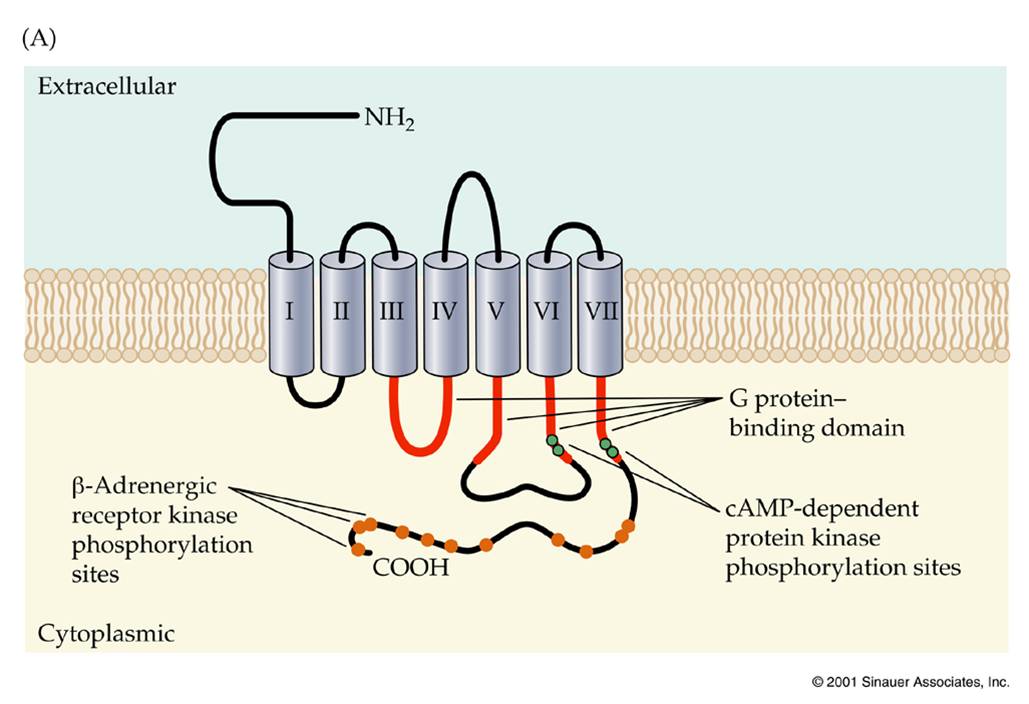Cards In This Set
| Front | Back |
|
What are the two mechanisms which G-proteins effect cell activity?(G-protein coupled receptors and enzyyme activation)
|
1. Through G-protein coupled receptors; when the G-protein is activated by it's receptor the alpha and beta/gamma subunits dissociate. The free subunits modulate the activity of the intracellular targets. When Ach binds to its muscarinic receptor on cells in the atrium of the heart, a G-protein is activated. The free beta/gamma subunit binds to ion channels, thereby slowing heart rate.
2. Activation of enzymes can also produce intracellular second messengers. Activation of G-Protein in cardiac muscle cells--> binding of NE to beta-adrenergic receptors --->alpha and beta/gamma subunits--->stimulate the enzyme adenylyl cyclase--> increased cAMP---> cAMP-dependent protein kinase---> phosphorylation. (may result in long lasting effects, and cascade of events) |
|
What are direct targets for transmitter activation?
|
Potassium and Calcium channels.
|
|
What effect does opening of potassium (via indirectly acting transmitters) channels have on N-type calcium channels?
|
The inhibit the calcium channels in the sympathetic neurons and increase the probability that calcium channels open in response to depolarization in cardiac muscle cells.
|
|
Draw a picture of the metabotropic or G-protein coupled receptor and explain it. (pg 178)
|
 See diagram |
|
What are the four different types of G-protein structures?
|
Gs--->Stimulate adenylyl cyclase
Gi---> Inhibit adenylyl cyclase Gq--> couples to phospholipase G12---> unknown targets |
|
Draw a diagram and describe how indirectly coupled transmitter receptors act through G proteins.
|
 Activation of a metabotropic receptor by its agonist on the extracellular side, activates a G-protein. The alpha subunit along with GDP dissociate from beta/gamma subunits. The GDP on the alpha subunit is exchanged for GTP (GDP is replaced with GTP), this causes the dissociation of the subunits. The free proteins bind and modulate the activity of their target proteins. |
|
What effect does the free alpha subunit have?
|
It has GTpase activating proteins or GAPs, which influences the rate at which GTP bound to the alpha subunit is hydrolyzed.
|
|
What does hydrolysis of GTP to GDP do?
|
Along with inorganic phosphate (Pi) by the endrogenous GTPase activity of the alpha subunit, leads to an association of the alpha/beta/gamma complex, terminating the response.
|
|
Whart are the two mechanisms that mediate desensitivation?
|
1. A Second messanger regulated kinase, such as cAMP-indepentant protein kinase, phosphorylates G-protein-coupled receptors blocking their interaction with G-proteins( this type of mechanism may be non selective: more than one transmitter may activate cAMP-dependent protein kinase, it may phosphorylate more than one type of G-protein coupled receptor).
2. There is also selective phosphorylaytion of activated receptors by a specific G-protein coupled receptor kinase or GRK, such as beta -adrenergic recrptor kinase (BARK). Then a protein of the arrestin family binds to the phosphroylated receptor, blocking its ability to activate G-proteins and thereby terminating the response. |
|
What effect does Ach binding have on mAch-R in the heart?
|
It causes the opening of potassium channels, thus causing the cell to hyperpolarize.
|
|
How has experimentation show the effect of mAch and potassium channels when activated?
|
Activation of muscarinic receptors is coupled to opening of potassium channels by G-proteins. It was found the intracellular GTP is required, the activation of potassium channels by muscarinic agonists is greatly prolonged by intracellular application of a nonhydrolyzable analgue of GTP (GPP) and that muscarinic activation of potassium channels is blocked by pertusis toxin which activated Gi proteins.
|
|
Describe the findings of the experiment regarding the inside out membrane patches.
|
It was shown that when pure recombinant beta/gamma subunit was applied to the intracellular side of the membrane through the patch potassium channels opened.
|
|
What did this demonstrate?
|
It demonstrated that the beta/gamma was responsible for the opening of potassium channels, not the alpha subunit.
|
|
What was found when muscarinic agonists were added to the patch clamp solution?
|
Potassium cell activity was increased. But when muscarinic solution was added to the bath solution then there was no effect on potassium channels.
|
|
So what does it mean to say that the cell is membrane delimted?
|
It meant that direct, mechanism of G protein action reflects the limited range over which beta/gamma subunits can act. (the activation only occured intracellualrly)
|



